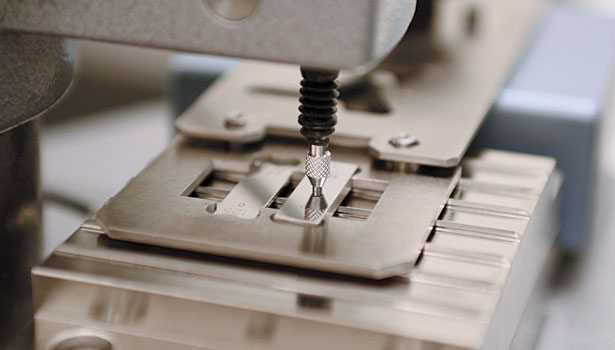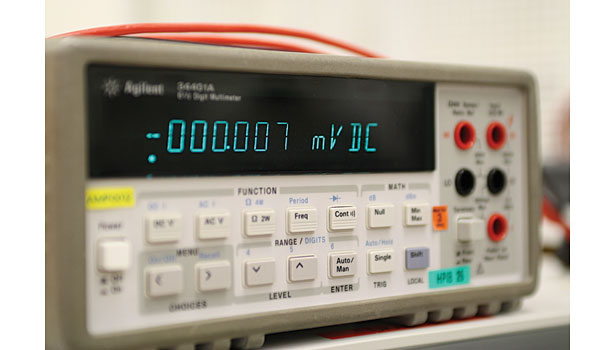Calibration of Measuring Equipment
It’s important to calibrate equipment both before and after use.






Assuring the quality of a measurement is crucial. In order to achieve the finest measurement and thereby the correct decision based upon it, calibration of equipment both before and after use is essential. This both establishes (metrological) traceability for the measurement and fulfills the requirements of ISO 9000.
Fundamentally, measurement is a process which checks whether something is correct within a set of specified limits. A decision on the results is based on whether the device being measured is inside or outside those limits. Clearly equipment to carry out the measurement is essential: either a simple gage, scale or thermometer; a more advanced measuring system such as a coordinate measuring machine (CMM); laser or vision based measuring systems; or electrical instruments like power supplies, multimeters, oscilloscopes, signal generators or spectrum/signal analyzers. For every one of these, pre and post measurement calibration is essential to ensure the most accurate outcomes.
TECH TIPSMeasurement is a process which checks whether something is correct within a set of specified limits. A decision on the results is based on whether the device being measured is inside or outside those limits. No matter what type of equipment is used, pre and post measurement calibration is essential to ensure the most accurate outcomes. |
Today’s systems are highly advanced, with precision hardware and software as the norm. The requirement on calibration and traceability of measuring equipment is, therefore, of increased importance. After measurement the analysis is now much more sophisticated and can include amendments to both hardware and software, with some software created to respond to measurement itself. The cost to purchase and maintain these systems is necessarily high and inevitably the focus for the user is on service of the hardware and upgrade of firmware/software to the latest versions rather than on calibration and traceability.
The concept of (metrological) traceability
A measurement is the process by which we obtain a value of a quantity which is expressed as the product of a numerical value and a measurement unit (numerical value • unit), for example:
Length of a rod 3.25 m (3.25 • 1 m)
Mass of a body 10.2 kg (10.2 • 1 kg)
Temperature of a body 55 °C (55 • 1 °C)
A measurement unit is a defined quantity of size “one” used as unit, for example:
Unit for length 1 meter (1 m)
Unit for mass 1 kilogram (1 kg)
Unit for temperature 1 kelvin (1 K)
It is standard within the industry to use measurement units known as (SI) as defined by the International Bureau of Weights and Measures (BIPM) under the Convention of the Metre signed in Paris in 1875. The convention, modified slightly in 1921, remains the basis of international agreement on units of measurement; BIPM now has fifty-five member states, including all the major industrialized countries (more at www.bipm.org).
The concept of traceability in metrology is that a measurement result is based on comparison with an SI rather than a statement of quantity. So, for instance, a measurement of length expressed as 3.25m is not just an indicator of the measuring equipment, but is rather a statement that the item is actually 3.25 times the stated unit of measurement (1 m) as defined in the International System of Units (SI). Traceability is obtained by calibration—establishing the relation between the indication of the measuring equipment and the value of a measurement standard—which in turn has an established relation to the definition of the SI unit (also obtained by calibration). The calibration provides a documented traceability for the measuring equipment known as the calibration certificate.
Traceability represents the uncertainty within a measurement. The ISO/IEC GUIDE 99 International vocabulary of metrology (VIM) defines traceability as the “property of a measurement result whereby the result can be related to a reference through a documented unbroken chain of calibrations, each contributing to the measurement uncertainty.”
All measurement means a comparison, directly or indirectly, with a measurement standard that has
an uncertainty
No measurement can be done perfectly so the measurement itself will always add some uncertainty
The measured value and its uncertainty defines an interval that with a certain probability (usually 95%) covers the “true value” of what is measured.
The measurement uncertainty complicates the outcome; the value may be inside the limit but the value plus the uncertainty may be outside the limit, which means that the “true value”—with some probability—may be outside the limit. To complicate matters further, the converse can also be the case. The risk factor of a measurement which can result in a decision to either discard or accept a device based on its results being within or outside limits, has to be considered carefully when the uncertainty comes into play.
The ratio between the test limits and the measurement uncertainty is called the Test Uncertainty Ratio (TUR); the larger the ratio, the lesser the decision making risk. However, reduced uncertainty means more accurate measuring equipment and/or more accurate calibration of the equipment which in turn can, not surprisingly, increase the overall cost of the test.
Uncertainty within measurement is also dependent on a term known as the calibration interval. A more frequent calibration interval will bring fewer uncertainties and less risk, but can be more expensive. Although this cost increase may not work for some budgets, the improved results often mitigate the apparently high cost of a calibration.
The ISO 9000 requirements on measuring equipment
Despite the wide range of industry standards most of them are aligned to ISO 9000.
The ISO 9001:2008 Quality management systems - Requirements are:
7.6 Control of monitoring and measuring equipment
The organization shall determine the monitoring and measurement to be undertaken and the monitoring and measuring equipment needed to provide evidence of conformity of product to determined requirements.
Where necessary to ensure valid results, measuring equipment shall
be calibrated or verified, or both, at specified intervals, or prior to use, against measurement standards traceable to international or national measurement standards;
be adjusted or re-adjusted as necessary;
In addition, the organization shall assess and record the validity of the previous measuring results when the equipment is found not to conform to requirements. The organization shall take appropriate action on the equipment and any product affected.
In the purchase of equipment, the manufacturer’s specifications are used to determine whether it is fit for purpose. In this way, these specifications become part of the (metrological) requirements for the intended use of the equipment (sometimes called the “maximum permissible errors”). This becomes more evident in the definition of metrological confirmation in ISO 9000:2005 Quality management systems - Fundamentals and vocabulary:
3.10.3 metrological confirmation
set of operations required to ensure that measuring equipment conforms to the requirements for its intended use
NOTE 1 Metrological confirmation generally includes calibration or verification, any necessary adjustment or repair, and subsequent recalibration, comparison with the metrological requirements for the intended use of the equipment, as well as any required sealing and labelling.
NOTE 2 Metrological confirmation is not achieved until and unless the fitness of the measuring equipment for the intended use has been demonstrated and documented.
NOTE 3 The requirements for intended use include such considerations as range, resolution and maximum permissible errors.
The measuring equipment has to be calibrated against a traceable measurement standard “at specified intervals, or prior to use” and the compliance with the specification (“maximum permissible errors”) has to be verified. The requirement that “the organization shall assess and record the validity of the previous measuring results when the equipment is found not to conform to requirements” implies that the measuring equipment also has to be calibrated after it has been used in order to “assess and record the validity of the previous measuring results.”
This means that the measuring equipment has a series of stages at which it should be calibrated. First off, to check compliance with the specification status “as received” to assure the quality of the measurements made during the last period of use. Secondly the device should “be adjusted or re-adjusted as necessary”; and after that it has to be re-calibrated and compliance with the specification status “as shipped” prepares for the next stage of use. Basically, each piece of new equipment requires initial and final calibrations.
Manufacturers calibrate equipment before delivery and also confirm compliance with the specification at that stage. The manufacturers should also provide a calibration procedure to verify the stated specification (often called “performance test”) including the adjustment procedure to update any corrections included in the software.
Software corrections
If the measuring equipment has corrections included in its software that affect the final result, this will be part of the calibration result, and any changes to these corrections are treated as adjustments. The equipment is calibrated before the adjustment to establish “status as received” and after the adjustment to establish “status as shipped.” This same procedure is followed for service of the hardware and/or upgrade of firmware or software that may also affect the measurement result.
The adjustment of any such software corrections is an implicit part of the calibration procedure required by ISO 9000 and, as such, the procedure to update the corrections should be made available by the manufacturer at the point of purchase; if not, the equipment has to be sent back to the manufacturer for adjustment.
Confidence in a product is enhanced if customers know that the measuring equipment has been thoroughly calibrated by an independent, competent calibration laboratory. This is particularly so if a third party has evaluated the laboratory itself; all accredited laboratories have been independently assessed by a nationally recognized accreditation body.
Accredited laboratories are accredited to ISO/IEC 17025 by the national accreditation bodies which are signatories to the Multilateral Agreements (MLA) of the European co-operation for Accreditation (EA) for mutual recognition of calibration certificates and test reports. The EA MLA is recognized at international level by International Laboratory Accreditation Cooperation (ILAC) and International Accreditation Forum (IAF).
This means that a calibration certificate accredited by an EA MLA signatory is also recognized by the signatories to the IAF and ILAC multilateral agreements. In this way, the EA MLA acts as an international passport to trade (read more at www.european-accreditation.org, www.ilac.org and www.iaf.nu).
References
ISO 9000:2005 Quality management systems – Fundamentals and vocabulary
ISO 9001:2008 Quality management systems – Requirements
ISO/IEC 17025:2005 General requirements for the competence of testing and calibration laboratories
ISO/IEC GUIDE 98 Uncertainty of measurement - Guide to the expression of uncertainty in measurement (GUM)
ISO/IEC GUIDE 99 International vocabulary of metrology (VIM)
Looking for a reprint of this article?
From high-res PDFs to custom plaques, order your copy today!








